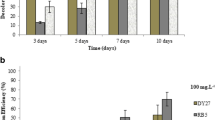Summary
The use of Phanerochaete chrysosporium biomass for the removal of Reactofix Golden Yellow from aqueous solution and eight textile dyes (four azo and four anthraquinone) from a synthetic effluent (0.6 g/l) at different pH, temperature and biomass concentrations was studied. Adsorption was maximum at pH 2.0 and 40 °C using 2.45 g mycelial biomass. The rate constant of adsorption was 1.95×10−1/min for Reactofix Golden Yellow and 1.64×10−1/min for synthetic effluent. In both cases, the equilibrium data fitted well in the Langmuir but not the Freundlich model of adsorption, and the adsorption was biphasic. Adsorption decreased the COD of Reactofix Golden Yellow and synthetic effluent by 54 and 57%, respectively. Desorption (80–84%) of dyes from P. chrysosporium mycelial surface occurred as the pH increased from 2 to 10.
Similar content being viewed by others
References
Asfour H.M., Fadali O.A., Nassar M.M., El-Geundi M.S., 1985 Equilibrium studies on adsorption of basic dyes on hardwood Journal of Chemical Technology and Biotechnology 35: 21–27
Bakshi D.K., Gupta K.G., Sharma P., 1999 Enhanced biodecolorization of synthetic textile dye effluent by Phanerochaete chrysosporium under improved culture conditions Wourld Journal of Microbiology and Biotechnology 15: 507–509
Bakshi, D.K. & Sharma, P. 2003 Evaluation of genetoxicity of textile dyes by Ames & rec assay Journal of Environmental Pathology, Toxicology and Oncology 22
Capalash N., Sharma P., 1992 Biodegradation of texitle azo-dyes by Phanerochaete chrysosporiumWorld Journal of Microbiology and Biotechnology 8: 309–312
Costan G., Bermingham N., Blaise C., Ferard J.F., 1993 Potential ecotoxic effect probe (PEEP): a novel index to access and compare the toxic potential of industrial effluents Environmental Toxicology and Water Quality 8: 115–140
Cripps C., Bumpus J.S., Aust S.D., 1990 Biodegradation of azo and heterocyclic dyes by Phanerochaete chrysosporiumApplied and Environmental Microbiology 56: 1114–1118
Garg V.K., Gupta R., Bala-Yadav A., Kumar R., 2003 Dye removal from aqueous solution by adsorption on treated sawdust Bioresource Technology 89: 121–124
HMSO. 1986 Chemical oxygen demand (dichromate value) of polluted and wastewaters, 2nd edition, pp. 8–20. ISBN 0117519154
Jain A.K., Gupta V.K., Bhatnagar A., Suhas. 2003 Utilization of industrial waste products as adsorbents for the removal of dyes Journal of Hazardous Materials 101: 31–42
Jaspers C.J., Penninckx M.J., 1996 Adsorption effects in the Decolorization of Kraft Bleach Plant effluent by Phanerochaete chrysosporiumBiotechnology Letters 18: 1257–1260
Khare S.K., Panday K.K., Srivastava R.M., Singh V.N., 1987 Removal of Victoria Blue from aqueous solution by Fly Ash Journal of Chemical Technology and Biotechnology 38: 99–104
Liversidge R.M., Lloyd G.J., Wase D.A.G., Forster C.F., 1997 Removal of basic blue 41 dye from aqueous solution of linseed cake Process Biochemistry 32: 473–477
McKay G., Otterburn M.S., Jamal A.A., 1985 Fuller’s earth and fried clay as an adsorbent for dyestuffs: equilibrium and rate studies Water Air and Soil Pollution 24: 307–322
Namasivayam C., Yamuna R.T., 1992 Removal of Congo Red from aqueous solution by biogas waste slurry Journal of Chemical Technology and Biotechnology 53: 153–157
Nawar S.S., Doma H.S., 1989 Removal of dyes from effluents using low-cost agricultural by-products Science of the Total Environment 79: 271–279
Safarikova M., Ptackova L., Kibrikova I., Safarik I., 2005 Biosorption of water soluble dyes on magnetically modified S. cerevisiae subsp. uvarum cellsChemosphere 59: 831–835
Singh V.N., Mishra G., Panday K.K., 1984 Removal of Congo Red by wollastonite Indian Journal of Technology 22: 70–71
Vandevivere P.C., Bianchi R., Verstraete W., 1998 Treatment and reuse of waste water from the textile wet-processing industry: Review of emerging technologiesJournal of Chemical Technology and Biotechnology 72: 289–302
Verma P., Madamwar D., 2002 Production of enzymes for dye decolorization by cocultivation of white rot fungus Pleurotus ostreatus and Phanerochaete chrysosporium under solid state fermentation Applied Biochemistry and Biotechnology 102–103: 109–118
Wang C.C., Juang L.C., Hsu T., Lee C.K., Lee J.F., Huang F.C., 2004 Adsorption of basic dyes onto montmorillonite Journal of Colloid and Interface Science 273: 80–86
Author information
Authors and Affiliations
Corresponding author
Rights and permissions
About this article
Cite this article
Bakshi, D., Saha, S., Sindhu, I. et al. Use of Phanerochaete chrysosporium biomass for the removal of textile dyes from a synthetic effluent. World J Microbiol Biotechnol 22, 835–839 (2006). https://doi.org/10.1007/s11274-005-9111-3
Received:
Accepted:
Published:
Issue Date:
DOI: https://doi.org/10.1007/s11274-005-9111-3




